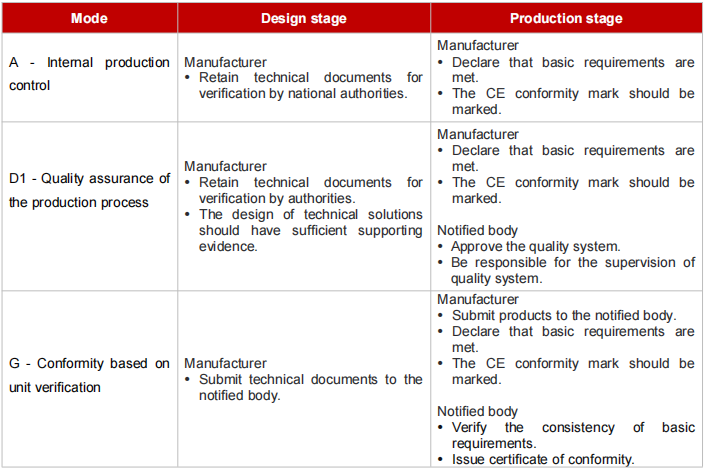What’s conformity assessment?
The conformity assessment procedure is designed to ensure that manufacturers meet all applicable requirements before placing a product on the EU market, and it is carried out before the product is sold. The main objective of the European Commission is to help ensure that unsafe or non-compliant products do not enter the EU market. According to the requirements of EU Resolution 768/2008/EC, the conformity assessment procedure has a total of 16 modes in 8 modules. Conformity assessment generally includes the design stage and the production stage.
Conformity assessment procedures of New Battery Regulation
The EU’s New Battery Regulation has three conformity assessment modes, and the applicable assessment mode is selected according to the requirements of product category and the production methods.
1) Batteries that need to meet the material limitations, performance durability, stationary energy storage safety, labeling and other requirements of the EU battery regulation:
Serial production: Mode A – Internal production control or Mode D1 – Quality assurance of the production process
Non-serial production: Mode A – Internal production control or Mode G – Conformity based on unit verification
2) Batteries that need to meet carbon footprint and recycled material requirements:
Serial production: Mode D1 – Quality assurance of the production process
Non-serial production: Mode G – Conformity based on unit verification
Comparison of different modes
Documentations
Technical documents :
(a) A general description of the battery and its intended use;
(b) Conceptual design and manufacturing drawings and schemes of components, sub-components and circuits;
(c) Description and explanation necessary to understand the drawings and schemes mentioned in point (b) and the operation of the battery
(d) Sampling label;
(e) A list of harmonized standards to be implemented in whole or in part for conformity assessment;
(f) If the harmonized standards and specifications mentioned in point (e) have not been applied or are not available, a solution is described to meet the specified applicable requirements or to verify that the battery complies with those requirements;
(g) Results of design calculations and tests performed, as well as technical or documentary evidence used.
(h) Studies that support the values and categories of carbon footprints, including calculations carried out by using the methods set forth in the enabling Act, as well as evidence and information to determine the data input to those calculations; (Required for mode D1 and G)
(i) Studies that support the share of recovered content, including calculations carried out by using the methods set forth in the enabling Act, as well as evidence and information to determine the data input to those calculations; (Required for mode D1 and G)
(j) Test report.
Template for conformity declaration:
1. Battery model name (product, category, batch number or serial number);
2. Manufacturer name and address, as well as its authorized representative (if applicable);
3. This declaration of conformity is the sole responsibility of the manufacturer;
4. The object of the declaration (description of the battery and a traceable marking, including, when necessary, an image of the battery);
5. The purpose of the declaration referred to in point 4 is consistent with the relevant harmonized EU legislation (with reference to other applicable EU legislation);
6. Reference to relevant harmonized standards or use of general norms, or reference to other technical specifications for which compliance is claimed;
7. Notified body (name, address, number) … carried out (intervention description) … and issued a certificate (details, including its date and, where appropriate, information about its validity and conditions) … ;
8. Additional information
Signed on behalf of:
(Place and date of issue) :
(Name and function)(Signature)
Notice:
- The EU declaration of conformity shall state that the product has demonstrated compliance with the requirements set out in the New Battery Regulation, such as carbon footprint, recycling, performance, etc.
- The EU declaration of conformity shall contain the requirements laid down in the conformity assessment procedure. Reports shall be drafted in electronic format and provided in writing upon request.
Conclusion
At present, among three conformity assessment procedures of the new battery regulation, mode A is the simplest one. As it does not require the participation of the notified body, but requires manufacturer to provide technical documents at the design stage, and that manufacturing stage meets the requirements of corresponding EU battery regulations and the CE Directive. On the basis of mode A, Mode D1 adds the quality system assessment and supervision of the notified body, and can only be declared if it meets the requirements. In mode G, product and technical documents need to be submitted to the notified body for audit and verification, who will issue a report and declaration of conformity.
Post time: Sep-04-2023



